|
ANADIL
Goddess of Life and Fertility
|
Intermediate Deity
Symbol: A white pine cone
Colors: White and brown
Alignment: Neutral Good
Portfolio: Birth, Children, Family
Worshipers: Halflings, Matrons, Doctors
Cleric Alignments: CG, LG, NG, N
Domains: Family, Healing, Luck, Protection
Favored Weapon: Knife
|
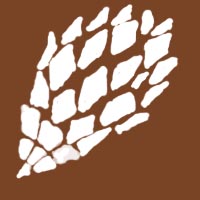
|
The motherly goddess of the Halflings, Anadil (AN-a-dil) is a
caring woman usually appearing with ornate brown robes and curly
white hair. Given her domain over birth, nearly every family says
a prayer to her at some point.
Clergy and Temples
The Motherly and Fatherly Guardians are a special group of
followers dedicated to taking care of communities or fellowships.
Time Of Change
Those communities that depend on the Motherly and Fatherly
Guardians suddenly find survival difficult. Many die from this
lack of survival ability, while others as destroyed by brigands.
Some fall to depravity.
AVALON
God of the Dead
|
Intermediate Deity
Symbol: A granite square
Colors: Mottled gray
Alignment: Lawful Good
Portfolio: Death, Healing, Tears
Worshipers: Morticians, Clerics
Cleric Alignments: LG, LN, NG
Domains: Death, Good, Renewal, Time
Favored Weapon: Sickle
|

|
Though most think of death as a tragedy, Avalon (AV-a-lon) is a
reminder of the eternal peace that death brings. He usually
appears as a graying Widdershin dressed in heavy granite colored
robes with a deep hood.
Dogma
Show compassion to those who have recently been close to death.
Show respect to the dead. Death is part of life and is a time
where we can learn and grow. Undead should be helped to meet
their final rest, either through the destruction of evil undead
or the assisting of good undead.
Clergy and Temples
Standing temples of Avalon are usually only found in major
cities, but temporary temples can be found at the site of any
major tragedy. Organized more like a charitable organization than
a church, priests and followers often take up humanitarian
missions. The High Minister of Avalon resides in the cathedral at
Watermouth in the elven lands. Most priests of Avalon are skilled
in dealing with people as well as the dead, but the Ferrymen are
a distinguished class of adventurers dealing with the undead.
Clerics of Avalon pray for their spells at dusk, taking solace in
the twilight.
Time Of Change
While the charitable missions become less grand due to lack of
spell support, the religion generally maintains its standing and
duties.
BINESIUS
God of Tyranny
|
Intermediate Deity
Symbol: An iron fist in front of a black banner on a
purple field
Colors: Iron, black, and purple
Alignment: Lawful Evil
Portfolio: Conquest, Nobility, Tyranny
Worshipers: Blackguards, Evil Nobles, Warlocks,
Frost Giants, Troglodytes
Cleric Alignments: LE, LN, NE
Domains: Nobility, Pride, Strength, Tyranny
Favored Weapon: Scepter (Club)
|

|
The tyrant god, Binesius (bin-E-shus) tolerates only obedience
and loyalty. He is a god of rulership and power appearing as a
Frost Giant in iron plate armor and fur-lined purple cloak. Atop
his head he wears an iron crown set with five black diamonds. In
depictions, his race is usually changed to match the locale.
Clergy and Temples
The Disciples of Tyranny (see Disciple of Asmodeus, BVD 57) are
an elite group of power-hungry lords that are among the highest
ranking members of the church.
Time Of Change
The kingdoms and cities ruled over by Binesius's followers were
typically suppressed by fear and the leaders were firmly
entrenched. Several became known to have lost their god's support
and were killed by rivals or underlings. This usually led to
civil war.
CANLUTH
God of Vengeance, Bastard King
|
Lesser Deity
Symbol: A black circle on a red background
Colors: Black and red
Alignment: Neutral Evil
Portfolio: Outcasts, Vengeance
Worshipers: Abandoned People, Vengeance-seekers
Cleric Alignments: CE, LE, NE, N
Domains: Mysticism, Retribution, War, Wrath
Favored Weapon: Pike (Longspear)
|
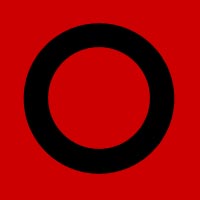
|
Championing the causes of the outcasts, Canluth (kan-LOOTH) is a
god dedicated to vengeance disguised as justice. His hatred is
well directed usually, but woe to those who get in the way.
Canluth often appears as a worg riding goblin wearing red and
black leather armor and wielding a pike.
Clergy and Temples
There is a little-known group known as the Black Circle which has
incredible influence among the church. They are said to be able
to strike vengeance from great distances.
Time Of Change
Hatred knows no bounds, and the church of Canluth didn't hold up
any socieities. So, other than the deminished capability of the
Black Circle, his followers were barely affected by his loss.
CHIHARE
God of Magic
|
Intermediate Deity
Symbol: Six stars on a field of blue
Colors: Yellow, orange, blue
Alignment: Lawful Neutral
Portfolio: Arcana, Artifacts, Spells
Worshipers: Magecrafters, Sorcerers, Wizards,
Eldritch Giants, Musgraves
Cleric Alignments: LE, LG, LN, N
Domains: Force, Magic, Mysticism, Spell
Favored Weapon: Quarterstaff
|

|
The god of wizardry and sorcery, Chihare (chee-HAR-ah) tends to
pay more attention to ley lines and books then the ways of
mortals. He tends to be arrogant but patient and appears as a
classic wizard depiction. He is usually a musgraf in flowing blue
robes, carrying a staff and wearing a pointed hat with six yellow
stars.
Clergy and Temples
Of special note, the Divine Arcanists are high priests of the
clergy that have merged arcane and divine casting prowess.
Time Of Change
The lack of divine magic destroyed the Magecrafters' ability to
create divine magic items. Since most of his powerful followers
are wizards and sorcerers, the lack of a god didn't destroy any
existing power structures. Most of them were already impacted by
the previous problems with magic.
CILINDA
Goddess of Charity
|
Lesser Deity
Symbol: A pair of open palm golden hands
Colors: Gold and white
Alignment: Neutral Good
Portfolio: Charity, Poverty
Worshipers: Clerics, Paladins, Volunteers
Cleric Alignments: CG, LG, NG, N
Domains: Creation, Family, Good, Protection
Favored Weapon: Light Mace
|
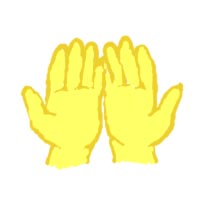
|
The goddess of the poor, Cilinda (sih-LIN-dah) is the champion of
the impoverished and the bane of money-grubbing tyrants.
Appearing as an Aasimar in white armor wielding a gold mace, she
is heroic and compassionate.
Clergy and Temples
The most renowned followers are the Golden Squires who dedicate
their lives to helping others.
Time Of Change
With the loss of Cilinda, the poor and downtrodden that were kept
alive and healthy through her power either ended up dead, or
further destitute. The disparity between the wealthy and the poor
has just worsened.
DAHJIHAI
Goddess of Wastes
|
Lesser Deity
Symbol: Bleached white bovine skull on sand
Colors: Light tan and white
Alignment: Neutral Evil
Portfolio: Famine, Wasteland
Worshipers: Sun Giants
Cleric Alignments: CE, LE, NE, N
Domains: Destruction, Evil, Pestilence, Sun
Favored Weapon: Falchion
|
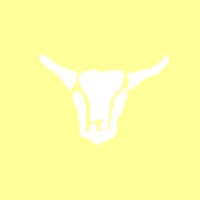
|
Goddess of the Sun Giants, Dahjihai (DAH-jee-HI) is a destroyer
of civilization and master of the wastelands. She usually appears
as a mummified sun giant wielding a petrified wooden falchion.
Clergy and Temples
Infamous among the clergy are the Blighters (see CD 23), a circle
of wasteland death druids.
Time Of Change
Having no racial city and a well established matriarchal society,
the loss of their goddess was felt deeply by the sun giants, but
didn't have a marked affect on them.
DEMOS
God of Fertility and Passion
|
Intermediate Deity
Symbol: A beanstalk
Colors: Deep green and pink
Alignment: Chaotic Neutral
Portfolio: Beauty, Fertility, Passion
Worshipers: Entertainers, Prostitutes, Satyrs
Cleric Alignments: CE, CG, CN, N
Domains: Family, Healing, Lust, Pride
Favored Weapon: Shortspear
|
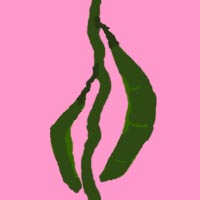
|
Often demonized by the conservative, Demos(DEE-moes) is the god
of free love and passion. The main conflict comes up when one
side of the free love cries rape. To Demos, love in the moment is
more important than thinking those things through. He appears as
a well groomed and masculine Satyr, often carrying a shortspear
wrapped with a bit of bean stalk.
Clergy and Temples
The most skilled of Demos' priests are the Wylders, who cast
powerful divine magics spontaneously through the forces of
passion.
Time Of Change
The Wylders were affected most by Demos' loss, as were those few
towns that worshiped lust as a culture. Most noticeably was the
spread of sexually transmitted diseases, which had been
controlled through magical intervention. This has led to the
Green Plague sweeping through the seedy sides of many cities.
Those clergy of Demos that survived the first year found a place
under the wing of Ahma-Buddha.
DESELA
Goddess of Greed
|
Intermediate Deity
Symbol: A fortified chest of gold
Colors: Gold and iron
Alignment: Neutral Evil
Portfolio: Greed, Treasure, Wealth
Worshipers: Nobles, Rogues, Tax Collectors, Kobolds,
Ogres
Cleric Alignments: CE, LE, NE, N
Domains: Envy, Greed, Lust, Wealth
Favored Weapon: Short Sword
|
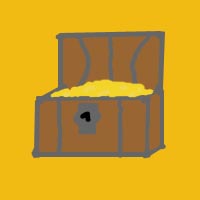
|
The goddess of Kobolds and all those that like to horde money,
Desela (DES-el-lah) exemplifies money-grubbing. Stingy and
shrewd, Desela appears as a kobold dressed in finery with a
jeweled short sword.
Clergy and Temples
Elite among the followers of Desela are the Ordained Raiders (see
Temple Raider of Olidammara, CD 67), a group of rogues blessed by
the power of their god.
Time Of Change
The lack of power from Desela led to a decrease in thievery and
the need to hire more people to handle tax collections. Of course
the decrease in thievery was only temporary, and the increase in
accounting staff led to more taxes.
DIZGA
God of Order
|
Intermediate Deity
Symbol: Three parallel lines
Colors: Violet and silver
Alignment: Lawful Neutral
Portfolio: Law, Order, Virtue
Worshipers: Judges, Monks, Dirmu, Widdersins
Cleric Alignments: LE, LG, LN, N
Domains: Law, Planning, Protection, Strength
Favored Weapon: Longsword
|

|
Dizga (DIZ-gah) is the god of law, structure, and order,
requiring temperance and discipline by his followers. These are
all aspects that he embodies himself. Dizga appears as a proud
Dirmu in silver armor with a shield bearing his symbol.
Clergy and Temples
The elite martial wing of the church is the Fists of Law,
dedicated to maintaining order.
Time Of Change
Those justices and leaders that relied on Dizga's wisdom have
been forced to make their own choices. Several have been murdered
by vengeful families of defendants after proof of Dizga not
providing divine wisdom to the judge as was portrayed. The Fists
of Law, while still capable martially have found themselves
protecting their own temples and court houses against riots.
EGROLIUS
God of Wealth
|
Lesser Deity
Symbol: A pile of gold coins on a silver field
Colors: Gold and silver
Alignment: Neutral
Portfolio: Commerce, Gambling
Worshipers: Accountants, Bankers, Rogues
Cleric Alignments: CN, LN, N, NE, NG
Domains: Greed, Luck, Trade, Wealth
Favored Weapon: Dagger
|
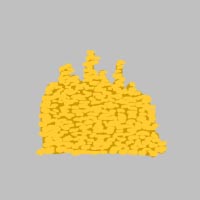
|
The patron of shopkeepers and commerce is Egrolius
(eg-RO-lee-us), god of wealth. Unlike Desela who hordes money,
Egrolius sees the value in money being able to provide other
luxuries. He usually appears as a gnome in silver silk clothes
with gold jewelry.
Clergy and Temples
The most reknowned of Egrolius' followers are the Patron Lords,
wealthy aristocrat adventurers.
Time Of Change
Very little of Egrolius' followers' powers were gained through
divine means. They continue to be wealthy and commerce continues
unabated.
ERIMETH
God of Freaks
|
Lesser Deity
Symbol: Disfigured humanoid head with a broken horn,
different sized eyes, and both a smile and frown
Colors: Orange and black
Alignment: Neutral Evil
Portfolio: Aberrations, Ugliness
Worshipers: Disfigured People, Aberrations,
Doppelgangers, Mongrelfolk
Cleric Alignments: CE, LE, NE, N
Domains: Envy, Evil, Gluttony, Hatred
Favored Weapon: Flail
|
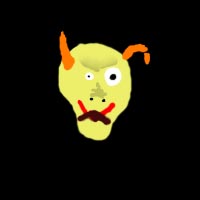
|
Born of hatred from being mocked and spit upon, Erimeth
(ERR-i-meth) is a god of ugliness and freaks. He usually appears
as an ugly and malformed humanoid of undetermined race and
gender, with a pair of horns, one of which is broken, and
carrying a bloody flail.
Clergy and Temples
Of particular note among the clergy are the Ascendant Thralls
(see Thrall of Demogorgon, BVD 67), creepy priests that slowly
transform into abominations over time.
Time Of Change
Without the support of their god, followers of Erimeth have
descended into madness, rage, and sometimes pacts with other dark
powers.
EXOLINDIUS
God of Flame, Arson Lord
|
Intermediate Deity
Symbol: Stylized orange and yellow flame on a red
field
Colors: Orange, yellow, and red
Alignment: Neutral Evil
Portfolio: Burning, Destruction, Malice
Worshipers: Shugenja, Sorcerers, Wizards, Fire
Giants
Cleric Alignments: CE, LE, NE, N
Domains: Destruction, Fire, Liberation, War
Favored Weapon: Two-Handed Sword
|
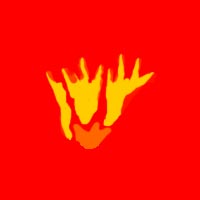
|
The darker side of fire, Exolindius (EX-oh-LIN-dee-us) is the
burning god of destruction. He is an angry god who enjoys
watching things and people burn. He appears as a fire giant in
red dragon scale armor wielding a two-handed flamberge sheathed
in flame.
Clergy and Temples
The Red Flame is the elite crusaders of the church of Exolindius,
having masterful control over fire.
Time Of Change
With the loss of control over fire, the priests quickly lost
control over their holdings. Sorcerers and fire giant warlords
have led civil wars, taking control of the castles and former
temples. Those temples that were in civilized areas have mostly
been burned to the ground by angry arsons.
FAIISBAR
God of Desolation
|
Intermediate Deity
Symbol: Sandstone pyramid
Colors: Light tan with white and gold
Alignment: Neutral
Portfolio: Deserts, Drought, Heat
Worshipers: Desert People, Asheratis, Thri-Kreen
Cleric Alignments: CN, LN, N, NE, NG
Domains: Destruction, Fire, Suffering, Sun
Favored Weapon: Kukri
|
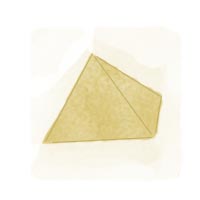
|
Often made out to be evil by those not from the deserts, Faiisbar
(FI-ihs-bar) is the embodiment of desolation. Desert folk
understand that heat, sun, and suffering are simply part of life
in the wastelands which care nothing about morality. Faiisbar
typically appears as an Asherati nomad in sand-colored linens
with a gold kukri.
Clergy and Temples
Well respected by their religion, and sought after by travelers,
the Oasis Guardians are true masters of the deserts.
Time Of Change
With the loss of Faiisbar, many desert folk have died. While the
teachings live on, entire towns have vanished in the wastes, and
places that were once traversable by following Oasis Guardians
are now just death traps.
FEMOLA
Goddess of Peace
|
Intermediate Deity
Symbol: Olive branch
Colors: Olive green and white
Alignment: Lawful Good
Portfolio: Mirth, Peace, Unity
Worshipers: Activists, Healers, Monks
Cleric Alignments: LG, LN, NG
Domains: Community, Good, Healing, Luck
Favored Weapon: Quarterstaff
|
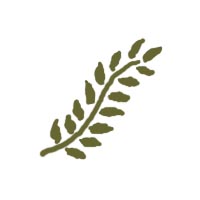
|
As the goddess of community, Femola (fe-MOH-la) is a gentle and
forgiving goddess dedicated to healing and happiness. She
typically appears as an Elf woman with olive green eyes, wearing
pure white clothes and always smiling.
Clergy and Temples
Constantly striving to achieve peace through non-violence are the
Apostles of Peace (see BED 51), a high ranking group of the
clergy.
Time Of Change
When the people were turned away from the monasteries and
sanctuaries, they grew angry. The claims that the priests
couldn't heal anymore was taken as trickery and brewed hatred.
Many of the monasteries were destroyed, leaving sorrowful undead
and ruins in their place.
GIL
Keeper of Souls
|
Intermediate Deity
Symbol: A skeletal key
Colors: White and maroon
Alignment: Lawful Evil
Portfolio: Promises, Undeath, Winter
Worshipers: Necromancers, Death Giants
Cleric Alignments: LE, LN, NE
Domains: Cold, Gluttony, Hunger, Undeath
Favored Weapon: Scythe
|

|
One of the most feared gods, Gil (gil) is the embodiment of
undeath and eternal imprisonment of the soul. To those
unfortunate enough to encounter him, Gil appears as a death giant
in maroon robes laced with bones. A ring of keys made of bones
jingles at his hip and he holds a scythe carved from the bones of
some large creature.
Clergy and Temples
The followers who get the closest to undeath without actually
dying are the Death Shapers (see Thral of Orcus, BVD 71), and for
that they are afforded unusual reverence among the church.
Time Of Change
When Gil went away, the millions of souls he had bound to him
were left to wander uncontrolled. The rise of undead was like a
plague. Death giants and necromancers that gained their power
through the arcane flourished, while those of the divine were
killed by the hordes. The champions of Jaringan have risen up to
fight back against the undead.
GORHAL
God of Deception
|
Lesser Deity
Symbol: A rainbow crescent
Colors: Gold and yellow
Alignment: Neutral Evil
Portfolio: Illusions, Lies
Worshipers: Bards, Illusionists, Rogues, Goblins
Cleric Alignments: CE, LE, NE, N
Domains: Competition, Evil, Illusion, Trickery
Favored Weapon: Dagger
|
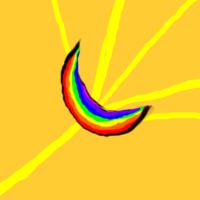
|
The god of lies and deception, Gorhal (gore-HALL) can only be
trusted enough to make sure he comes out on top. His main form is
that of an aged goblin dressed in prismatic robes, but as the god
of illusions, he rarely shows up in the same form twice.
Clergy and Temples
Within the ranks (actually at the top) of Gorhal's followers are
the Lie Casters (see Thrall of Graz'zt, BVD 69), spell casters
exceptionally adept at misleading.
Time Of Change
Most of Gorhal's followers were arcane casters, and therefore not
directly impacted by his loss. The Lie Casters however were
uncovered, truths were revealed, and mutinies errupted.
HAIJISA
Goddess of the Sun
|
Intermediate Deity
Symbol: A golden disk with an eye in the center
Colors: Gold and yellow
Alignment: Lawful Good
Portfolio: Healing, Light, Sun
Worshipers: Desert People, Druids, Clerics
Cleric Alignments: LG, LN, NG
Domains: Glory, Healing, Oracle, Sun
Favored Weapon: Morningstar
|
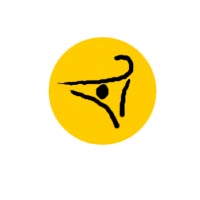
|
As the Goddess of the Sun, Haijisa (HI-jee-sah) has one of the
most visible reminders of her presence. Many cultures revere her
as the sun is necessary for their survival. Haijisa is friendly
and caring to the living, but detests undead.
Dogma
Followers of Haijisa are charged with bringing wisdom and light
to the world. Advice is to be given to those worthy of it, and
evil is to be cast into darkness. Those who are reverent are to
be provided with healing light, and those of undeath are to be
burned by it.
Clergy and Temples
Haijisa's church is held in high esteem and is near to nobility
in many cities. Her priests are often close advisers to leaders
but at the same time are close to the common people. The Radiant
Servants (see Radiant Servant of Pelor, CD 52) are the battle
wing of the church, trained to heal their allies and combat
undead hordes. Temples to Haijisa almost universally have open or
transparent roofs, allowing sunlight to flood the temples.
Clerics of Haijisa regain their spells at sun rise.
Time Of Change
When Haijisa vanished, the sun disappeared from the sky. Though
it rose the next day, the damage had been done. Panic ran through
the countryside. It wasn't long before it was found that the
clerics had been doing prophesies and providing advice for months
without their divine oracle abilities that they claimed to have.
The temples were ransacked and the nobles had the high priests
and advisers executed. When the undead plague began her priests
found power through Jaringan and acted as a formidable force to
halt it. Since thta shift, former followers of Haijisa have
almost all converted to worship of the new God of the Sun.
HEIMEUS
God of the Sky
|
Intermediate Deity
Symbol: A white feather with a gold halo
Colors: White and light blue
Alignment: Chaotic Good
Portfolio: Clouds, Flight, Sky
Worshipers: Cloud Giants, Raptorans, Tik-Ani
Cleric Alignments: CG, CN, NG
Domains: Air, Good, Liberation, Windstorm
Favored Weapon: Javelin
|
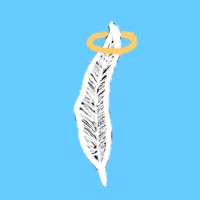
|
The ruler of the sky above land, Heimeus (HI-me-us) shares the
air with his twin Omethis. He is a righteous and freedom-loving
god that appears as a Raptoran with white wings, wearing light
blue scale armor and carrying a javelin.
Dogma
The ground is over run by people, plants, animals, monsters,
buildings, and ruins. The sky on the other hand remains clean,
open, and scarcely populated by birds, dragons, and other
creatures of the clouds. Assist those of the sky, and make sure
ground dwellers understand the sanctity of the air. Those who
treat the air with respect should be held in favor, while those
who fill it with smoke or constructs should be met with
resistance.
Clergy and Temples
The Skyking is the head of the church of Heimeus and the ruler of
the city of Aerion. While the most impressive temples to the God
of the Sky are built on the solid clouds of the cloud giants,
silver dragons, and tik-ani, there are several land-based temples
as well. They are most notable for their tower shapes with narrow
bases and larger tops. Obviously all priests of Heimeus have an
affinity for air, and many have some power of lightning or
electricity. All of the highest ranking clergy can fly or have
flying mounts. The elite holy crusaders, the Skylords (see BED
71), fight in Heimeus' name from atop such aerial mounts. Clerics
of Heimeus pray for their spells after breakfast, ready to begin
a new day.
Time Of Change
With the disappearance of Heimeus, the sky nations were rocked.
His temples collapsed, several of them falling through the clouds
to the ground far below. The wisdom and strength of the cloud
giants and silver dragons held the sky nations together, but
their interaction with the ground dwellers has almost completely
ceased.
HOLONTIER
God of Wanderlust
|
Lesser Deity
Symbol: Dirt path through fields of grain headed
towards distant mountains
Colors: Brown, tan, and blue
Alignment: Chaotic Neutral
Portfolio: Longing, Nomads
Worshipers: Nomads, Catfolk, Goliaths
Cleric Alignments: CE, CG, CN, N
Domains: Chaos, Fate, Time, Travel
Favored Weapon: Spear
|
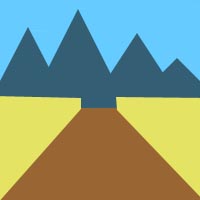
|
Filled with longing and a never-ending sense to keep moving,
Holontier (holl-ON-teer) is the god of nomads and patron to
nomadic peoples. He typically appears as a Goliath dressed in
travelers garb, carrying a lute and a spear.
Clergy and Temples
The most respected of Holontier's clerics are those called Trail
Blazers, embodying their god's ideals.
Time Of Change
With the sudden lack of their god, the catfolk and goliaths
nomads found their hard lives even harder. They could no longer
count on divine food and magically pure water. Their protections
from the elements no longer held. Many died, and those that
survived became even more primal.
INUNALLAH
God of Floods
|
Lesser Deity
Symbol: The outline of a drowning face in a field of
deep blue
Colors: Dark blue and black
Alignment: Neutral Evil
Portfolio: Disease, Floods
Worshipers: Druids
Cleric Alignments: CE, LE, NE, N
Domains: Destruction, Evil, Pestilence, Water
Favored Weapon: Heavy Mace
|
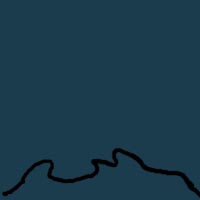
|
The god of flooding and the disease it brings, Inunallah
(in-un-AHL-ah) is a merciless god. He usually appears as a Taman
with frog-like features, dressed in rotting dark blue robes.
Clergy and Temples
At the top of the church are the Mire Adepts, unholy casters
dedicated to plagues and pestilence.
Time Of Change
The loss of Inunallah has had little affect on the world as a
whole. Natural plagues and floods still occur, and there is so
much other bad stuff going on that people don't generally notice
it has lessened.
IOMILIA
Goddess of Beauty
|
Lesser Deity
Symbol: A peach ribbon running across a field of
pink
Colors: Peach and pink
Alignment: Neutral Good
Portfolio: Beauty, Love
Worshipers: Artists, Bards
Cleric Alignments: CG, LG, NG, N
Domains: Charm, Good, Protection, Renewal
Favored Weapon: Rapier
|
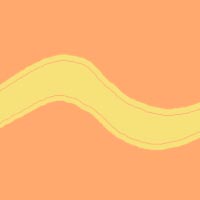
|
The goddess of artists and models, Iomilia (EE-oh-MIL-ee-ah)
nurtures love through beauty. She typically appears as a
spellscale of unsurpassed beauty with pink flecks on her scales,
wearing an ornate peach dress and wide-brimmed hat.
Clergy and Temples
Capturing beauty through music, the Troubadours of Stars (see BED
79) are a special group of the church welcomed at any high
society event.
Time Of Change
With the lack of divine magical support, many of Iomilia's church
have fallen to baser activities. People previously driven by
beauty have turned to drugs and alcohol to reduce the pain of
their loss. A number of her followers have taken refuge with
followers of Merran. The Troubadours of Stars mostly changed
faiths to worship Ahma-Buddha and his love for celebration.
KAZT
Ruler of Anarchy, Master of Chaos
|
Intermediate Deity
Symbol: Eight-pointed chaos arrows
Colors: Bright red and orange
Alignment: Chaotic Neutral
Portfolio: Anarchy, Chaos, Luck
Worshipers: Barbarians, Rogues
Cleric Alignments: CE, CG, CN, N
Domains: Chaos, Liberation, Luck, Travel
Favored Weapon: Handaxe
|
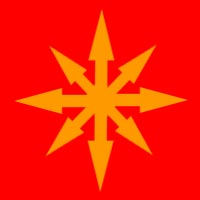
|
Unpredictable as a spark on the wind, Kazt (kazt) is chaos
incarnate. If he had his way, all civilization would be destroyed
and people left to live open in the world, dependent only on
themselves. Kazt typically appears as a large Ogre with bright
red eyes, wearing orange leather armor and carrying a well-used
handaxe.
Clergy and Temples
The most fanatical and revered champions of Kazt are the Ordained
Anarchists.
Time Of Change
Many of Kazt's followers initially saw their disappearance of
power as a random chaotic event put forth by their god to
challenge them. Over time leaders have lost the faith of their
tribes or followers, and by recognizing the loss of so many other
gods, they realize this isn't a test by Kazt. Depression
hardening to rage has swept through them.
KOLINBAR
God of Stone
|
Intermediate Deity
Symbol: Dark brown triangle on a granite gray
background
Colors: Granite gray and dark brown
Alignment: Lawful Neutral
Portfolio: Mining, Mountains, Stone
Worshipers: Sculptors, Dwarves, Stone Giants,
Stonechildren
Cleric Alignments: LE, LG, LN, N
Domains: Cavern, Craft, Earth, Strength
Favored Weapon: Heavy Pick
|
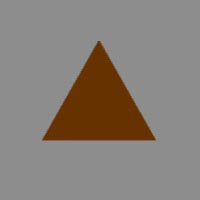
|
Nurbias's prodigy, Kolinbar (koe-LIN-bar), the God of Stone,
usually appears as a Stone Giant wielding a heavy pick made of
stone and wearing dark brown leathers. He is a humorless deity
with emotions that match the stone he works with.
Dogma
Stone is true, reliable, and is the foundation of the world. From
the caverns of the underworld to the mountains of the surface,
stone is unrelenting and ever present. The rest of the world may
do its thing, but our duty is to cultivate the stone. Use stone
in its natural form when you can, but know that it will be
reliable and hold any form you give it. Use the strength of stone
to help you provide a reliable foundation for others.
Clergy and Temples
The religion of Kolinbar is a rigid structure with a well-defined
hierarchy. The center of the religion is the High Supreme Mason,
located in Metea. All clergy are expected to give lifetime
commitments to the church, including a one year sabbatical to
encourage reliance on Kolinbar. Those who enter the rank of
clerics are given the freedom to adventure in Kolinbar's name.
Elite among them are the Granite Legion. Clerics of Kolinbar
regain their spells at Noon.
Time Of Change
In many dwarven, stone giant, and stonechild settlements, it was
clerics of Kolinbar that provided healing and community support.
With this gone, the church has lost a lot of its privilege.
Still, the masons of Kolinbar continue to be the best in the
world and are sought after.
KUPRIA
Goddess of Rain
|
Lesser Deity
Symbol: Blue drop of water on a light gray field
Colors: Blue and light gray
Alignment: Neutral Good
Portfolio: Cleanliness, Rain
Worshipers: Druids, Farmers
Cleric Alignments: CG, LG, NG, N
Domains: Air, Healing, Purification, Water
Favored Weapon: Rainstick (Club)
|
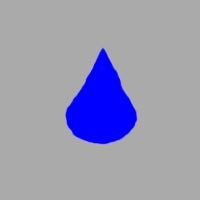
|
The goddess of farmers and gardeners, Kupria (KOO-pree-ah) is the
spirit of the soothing spring rain. She often appears as a small
animal with blue eyes, but occasionally appears as a pixie
dressed in blue water.
Clergy and Temples
The Disciples of Purity are a group of Kupria's clerics that
specialize in cleansing and restoration, and are of high regard
throughout the church.
Time Of Change
The loss of cleansing and restoration powers has left the clerics
of Kupria unable to help the lands that they have supported for
so long. Instead, areas have turned rancid or simply dried up.
The clerics have been abandoned by the masses, though the often
seek sanctuary with the druids.
LAMTORAK
God of Fury
|
Intermediate Deity
Symbol: Yellow tribal markings on a orange-red field
Colors: Yellow and orange-red
Alignment: Chaotic Evil
Portfolio: Fanatics, Hate, Rage
Worshipers: Barbarians, Bugbears, Hill Giants,
Minotaurs
Cleric Alignments: CE, CN, NE
Domains: Courage, Destruction, Hatred, Wrath
Favored Weapon: Battleaxe
|
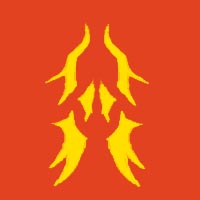
|
The god of wrath and hatred, Lamtorak(LAM-tor-ak) is furious and
unpredictable. He typically appears as a minotaur with orange-red
fur and his recognized tribal markings along his horns.
Clergy and Temples
The most feared of Lamtorak's followers are the Holy Ragers (see
Champion of Gwynharwyf, BED 57), a group of barbarians with
unholy backing.
Time Of Change
The lost of Lamtorak has meant the downfall of the ruling class
in Minos, not because they were his followers, but because those
tyrants relied on the strength of his followers to keep the city
in check. His loss was also felt among the Brass Mercenaries
where many Holy Ragers had found a calling.
|
LEDORIAN
God of Nightmares
|
Intermediate Deity
Symbol: Humanoid silhouette with four putrid
tentacles in front of a field of teeth
Colors: Black, white, and putrid green
Alignment: Chaotic Evil
Portfolio: Fear, Illusions, Madness
Worshipers: Enchanters, Illusionists
Cleric Alignments: CE, CN, NE
Domains: Dream, Envy, Madness, Mind
Favored Weapon: Dagger
|
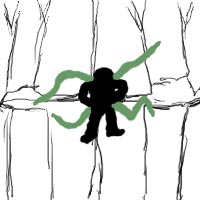
|
Sometimes referred to as the bogeyman, Ledorian (led-DORE-ee-an)
is the god of nightmares and madness. He revels in fear and the
deterioration of the mind. When visible, Ledorian appears as an
ogre mage dressed all in black with his face painted white except
for his putrid green eyes.
Clergy and Temples
Among the elite of the church are the Architects of Terror, a
group of casters extremely adept at getting into their targets
minds and under their skin.
Time Of Change
Ledorian's priests maintained several insane asylums around the
world. When their magic went away, the crazy people took over.
MALGONDIS
God of Shadow
|
Intermediate Deity
Symbol: Pair of dark gray eyes in a field of black
Colors: Dark gray and black
Alignment: Neutral Evil
Portfolio: Darkness, Secrets, Thieves
Worshipers: Rogues, Smugglers, Skulks
Cleric Alignments: CE, LE, NE, N
Domains: Darkness, Mind, Spider, Trickery
Favored Weapon: Short Sword
|
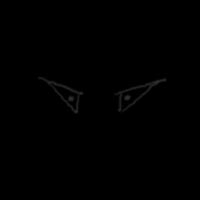
|
Lord of darkness and secrets, Malgondis (mal-GONE-dis) is a
whisper on the wind or a black spot in a shadow. When he chooses
to appear, it is always in darkness and he is a Skulk wearing a
black body suit, black cloak, and ornate faceless mask.
Clergy and Temples
Individually disturbing, the Dark Ones are a rank of high priests
of Malgondis whos skill with shadows, thievery, and assassination
are downright terrifying as a group.
Time Of Change
The Dark Ones became a secret cabal within the Shades Elite,
running many of the underworld missions. They've prayed to dark
entities to regain a semblance of their original power. Some have
regained near full capability under Sazia's control.
MERRAN
God of Art
|
Intermediate Deity
Symbol: Red eye on a violet field
Colors: Red and violet
Alignment: Neutral
Portfolio: Art, Dance, Music
Worshipers: Artists, Critics
Cleric Alignments: CN, LN, N, NE, NG
Domains: Charm, Craft, Illusion, Pride
Favored Weapon: Rapier
|
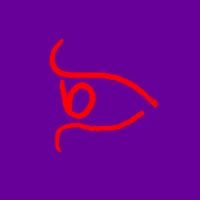
|
The god of all forms of fine art, Merran (mer-AHN) is fanciful
and opinionated. He usually appears as a gnome dressed in red and
violet finery, wearing a monocle on his left eye.
Clergy and Temples
Most respected among Merran's followers are the Divine
Entertainers who literally create works of art with divine
inspiration.
Time Of Change
The church didn't really have great power, so the loss of their
god wasn't a huge setback. Art continues, and those who followed
Merran were among the best artists. The Merran Institute of Art
continues operation.
NORRAL
God of Travel
|
Intermediate Deity
Symbol: Ivory walking stick
Colors: Light brown with white trim
Alignment: Lawful Good
Portfolio: Distance, Swiftness, Travel
Worshipers: Caravans, Scouts, Travelers
Cleric Alignments: LG, LN, NG
Domains: Celerity, Law, Portal, Travel
Favored Weapon: Quarterstaff
|
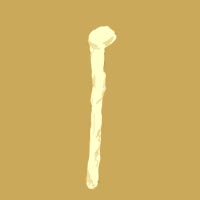
|
The god of the safe journey, Norral (nor-AL) is revered by
caravan masters. Those in his good graces can make excellent
travel time and move about safely. Luckily, Norral generally like
travelers. He usually appears as an elderly Lupin in travelers
clothes, relying heavily on an ivory walking stick.
Clergy and Temples
Among the followers of Norral are the Divine Pilots, travel
specialists that are sought after to lead ships and caravans.
Time Of Change
With the lack of magical aid, many of Norral's followers lost
their jobs or their lives. The Divine Pilots lost all respect and
their leader committed suicide. Most of the surviving clergy have
become nomads, hermits, or wastrels.
OMETHIS
God of Storms, Thunder Lord
|
Intermediate Deity
Symbol: Black cloud with a pale lightning bolt on a
dark gray field
Colors: Dark gray and pale yellow
Alignment: Chaotic Evil
Portfolio: Lightning, Storms, Wind
Worshipers: Evokers, Rangers, Wizards
Cleric Alignments: CE, CN, NE
Domains: Air, Destruction, Storm, Windstorm
Favored Weapon: Spear
|
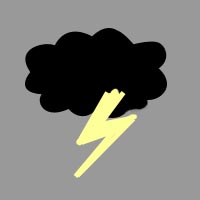
|
The ruler of the sky above sea, Omethis (oh-METH-is) shares the
air with his twin Heimeus. He is a moody and sadistic god that
appears as a Raptoran with dark gray wings, wearing pale yellow
scale armor and carrying a spear.
Clergy and Temples
Befitting the Thurder Lord, his divine champions go by the name
Stormlords (see CD 65), and are accorded much respect in the
church.
Time Of Change
The sudden lack of lightning power and weather control toppled
Omethis' followers. Luckily very few societies were built off
their power, so the overall affect was minor.
OPHERUS
God of the Seas
|
Intermediate Deity
Symbol: Blue light house with a gold light
Colors: Dark blue, light blue, and gold
Alignment: Chaotic Neutral
Portfolio: Sea, Tides, Waves
Worshipers: Sailors, Darfellans, Ocean Giants,
Hadozee, Sea Kin
Cleric Alignments: CE, CG, CN, N
Domains: Celerity, Ocean, Planning, Water
Favored Weapon: Scimitar
|
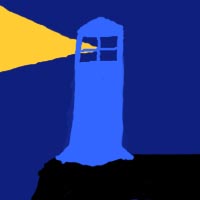
|
The oceans are the domain of Opherus (OH-fur-us), god of the
waves. He is a fickle god that likes to challenge his followers.
He typically appears as an Ocean Giant in glimmering gold scale
armor, wearing a crown of coral and wielding a scimitar that
seems forged of the very ocean itself.
Clergy and Temples
Feared on the high seas, but respected among the church, the
Tideriders are an order of divine pirates.
Time Of Change
Piracy and shipping have both been hindered by the loss of
Opherus. As the central religion to the Darfellans and Ocean
Giants, their communities have found themselves lacking healing
and divine support. This has led their various towns to either
become more secluded, or to reach out for support at the surface.
PARIONTOR
God of Atonement
|
Intermediate Deity
Symbol: Red head with black goat horns and concerned
eyes
Colors: Red, black, and white
Alignment: Neutral
Portfolio: Discipline, Forgiveness, Penance
Worshipers: Fallen Clerics and Paladins, Prisoners,
Sharakim
Cleric Alignments: CN, LN, N, NE, NG
Domains: Balance, Knowledge, Purification, Renewel
Favored Weapon: Longsword
|
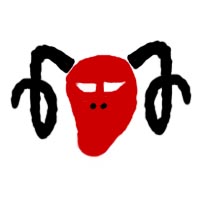
|
The god of forgiveness and penance, Pariontor (pare-ee-ON-tor)
embraces those who have lost their way and seek to regain their
footing. Be they good or evil, those seeking to make up for an
act are likely to call upon him. Other gods who are failed by
mortals will often call on Pariontor to enforce penance. He
usually appears as a Tiefling with red skin and black goat horns
dressed in white chain. His eyes always show deep compassion and
concern.
Clergy and Temples
Among the high priests are those known as Confirmed Redeemers,
the most adept and enforcing pennance and seeing to atonment.
Time Of Change
With the loss of gods, many people flocked to the followers of
Pariontor to find out what they did wrong. When the clerics were
unable to help, as they had lost their own god, panic spread. Few
prisons or temples have been targeted by vengeance or hatred,
though most of the temples have been abandoned, the clergy
finding a welcoming hand in the church of Jahnian.
PHERON
God of Light
|
Intermediate Deity
Symbol: A white sphere
Colors: White
Alignment: Lawful Neutral
Portfolio: Light, Sight, Stars
Worshipers: Druids, Wizards
Cleric Alignments: LE, LG, LN, N
Domains: Darkness, Glory, Moon, Sun
Favored Weapon: Quarterstaff
|

|
The god of all light and its effects, Pheron (FARE-on) controls
the dim twinkle as much as the brilliant glow. He is a personable
and jolly god that usually appears as a Musgraf in a white suit
with the glimmer of stars in his eyes.
Clergy and Temples
A small group of followers of Pheron known as the Light Twisters
(see Shadowspy, CC 105) are highly viewed by the church for their
masterful manipulation of light.
Time Of Change
Pheron didn't have a large clergy of clerics. Most of his
followers were actually druids or arcane casters, so his loss was
felt more in the heart than in the hand.
QOLGORITAL
Great Old Eye
|
Lesser Deity
Symbol: Angry yellowed eye with red iris on a putrid
green field
Colors: Yellow-white and pale olive green
Alignment: Chaotic Evil
Portfolio: Beholders, Malice
Worshipers: Beholders
Cleric Alignments: CE, CN, NE
Domains: Destruction, Domination, Knowledge, Spell
Favored Weapon: Dagger
|
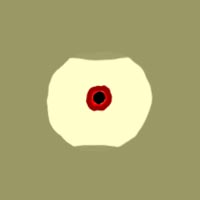
|
Worshiped almost exclusively by Beholders, Qolgorital
(kall-GORE-it-tall) is the embodiment of malice with magical
backing. The Great Old Eye appears as a bloated putrid green
beholder with yellowed eyes and teeth.
Clergy and Temples
The Destructive Eyes are high priests of Qolgorital adept with
eye-based magic.
Time Of Change
The priests of Qolgorital have found themselves slaughtered by
the beholders that they used to rule over. His cults of other
races have just gone further into hiding, having lost their
divine aid to spreading hatred.
REDOMEL
God of Bounty
|
Intermediate Deity
Symbol: Cornucopia, fruits, and loaf of bread
Colors: Wheat yellow and green apple
Alignment: Neutral Good
Portfolio: Abundance, Agriculture, Animals
Worshipers: Farmers, Hunters
Cleric Alignments: CG, LG, NG, N
Domains: Animal, Creation, Gluttony, Plant
Favored Weapon: Flail
|
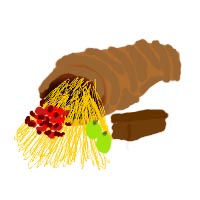
|
The god of abundance, Redomel (reh-DOM-ell) is happy to make
people fat. He enjoys the fresh harvest and the scent of a
kitchen. Redomel appears as a rotund Halfling with wheat colored
hair, usually carrying a bushel of green apples.
Clergy and Temples
Although most of Redomel's followers are normal folk, the
Bounteous Farmers are champions of the god and well regarded in
any community.
Time Of Change
Redomel didn't have a lot of clerics, and virtually no paladins.
Those few areas that relied on his clerics' aid for healthy
harvest have become bitter and impoverished. Most of his ranger
and druid followers have found a welcoming home with Dirj.
RUMINIS
God of Sacrifice
|
Intermediate Deity
Symbol: Light blue shield with a diagonal blood-red
stripe
Colors: Light blue and blood red
Alignment: Chaotic Good
Portfolio: Charity, Protection, Sacrifice
Worshipers: Barbarians, Clerics, Fighters
Cleric Alignments: CG, CN, NG
Domains: Courage, Good, Mysticism, Protection
Favored Weapon: Bastard Sword
|
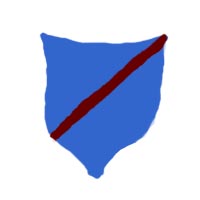
|
The god of self-sacrifice, Ruminis (roo-MIN-iss) is the champion
of martyrs and protector of the weak. He often appears as a
Mirbold in an ornate breast plate and with a shield that is his
symbol.
Clergy and Temples
Embodying Runinis' ideals, the Holy Defenders (see Defender of
Sealtiel, BED 58) are held in high esteem by the church for their
protection.
Time Of Change
A defender without his armor or sword can not do his job. Same
goes with the clerics and paladins of Ruminis that relied on his
magic to aid them in defending the weak. Thus, uprisings and mobs
could not be held back by Ruminis' followers as they tried to
protect the churches of peace. True to their god's sprit, many of
them have sacrificed their lives.
SANGIBAN
God of Justice
|
Intermediate Deity
Symbol: A black shield with a gold dragon
Colors: Black and gold
Alignment: Lawful Good
Portfolio: Justice, Retribution, Truth
Worshipers: Fighters, Monks, Paladins
Cleric Alignments: LG, LN, NG
Domains: Balance, Inquisition, Law, Retribution
Favored Weapon: Longsword
|
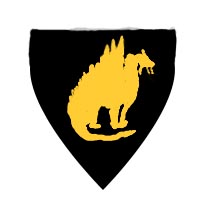
|
The god of truth, Sangiban (SANG-ih-bahn) strives for fair trials
and the elimination of the corrupt. When the worst injustices
take place, Sangiban may show up as an Elf with golden eyes and
hair, in black plate, carrying the shield that is his symbol.
Clergy and Temples
Deeply respected by the church, and feared by the corrupt, the
Truth Seekers (see Church Inquisitor, CD 26) are champions of
Sangiban dedicated to ferreting out lies and punishing
wrong-doers.
Time Of Change
Suddenly unable to magically discern truth from lies, the Truth
Seekers and other clerics of Sangiban found themselves no better
at striving for justice than anyone else. With the uproar against
the church of Haijisa and Dizga for feigning capability, the
church of Sangiban came clean and stepped out of the spotlight of
most governments. When the riots happened, they were safely in
their cloisters, waiting for the chaos to die down. Many people
espoused them as cowards and the lack of power in their paladins
as proof.
STALNOR
God of Courage
|
Intermediate Deity
Symbol: Tan lion's head on a field of red
Colors: Tan and red
Alignment: Lawful Good
Portfolio: Discipline, Endurance, Valor
Worshipers: Paladins, Soldiers
Cleric Alignments: LG, LN, NG
Domains: Competition, Courage, Law, Strength
Favored Weapon: Longsword
|
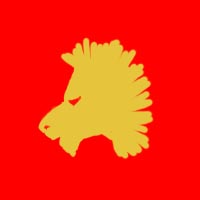
|
The god of bravery, Stalnor (STAHL-nohr) leads by his fearless
example. He usually appears as a broad-shouldered catfolk with
lion-like appearance, wearing gleaming red armor and wielding an
ornate longsword.
Clergy and Temples
The elite warriors of Stalnor are known as the Fearless Swords
(see Fist of Raziel, BED 63).
Time Of Change
A paladin without his paladin abilities is at least still capable
of battle. For that reason, the followers of Stalnor weren't as
bad off as the other religions that rely on their clerics.
Feeling the loss of their god, many of the paladins swore to
Jilis and have regained their glory.
TALWERIAN
God of the Wild
|
Intermediate Deity
Symbol: Ivory fang or horn on a field of green
Colors: Ivory and green
Alignment: Chaotic Evil
Portfolio: Instinct, Oozes, Wild Beasts
Worshipers: Barbarians, Druids, Mountain Giants,
Lizardfolk
Cleric Alignments: CE, CN, NE
Domains: Animal, Scaleykind, Slime, Spider
Favored Weapon: Great Axe
|

|
The Beast Lord, Talwerian (tahl-WARE-ee-an) takes on the creepy
and deadly aspects of nature. He usually appears as a lizard folk
covered in ooze and accompanied by a swarm of vermin.
Clergy and Temples
Among the most respected followers of Talwerian are the Vermin
Lords (see BVD 73).
Time Of Change
Nearly all of Talwerian's clergy are druids, but those few that
were clerics found themselves devoured by the vermin they once
controlled. The rest continue on as a cult without a real god,
drawing their power from nature.
TOLONDAR
Fisher King
|
Lesser Deity
Symbol: A bright blue fish on a sea blue field
Colors: Shades of blue
Alignment: Chaotic Good
Portfolio: Fishing, Sea Creatures
Worshipers: Fishermen, Shoreline People, Aventi,
Tamen
Cleric Alignments: CG, CN, NG
Domains: Animal, Creation, Ocean, Water
Favored Weapon: Trident
|

|
With the power of a blue whale and the energy of a hooked marlin,
Tolondar (tolh-ON-dar) is the god of sea creatures. Protective
but realistic, he recognizes the need for food that his charges
fill. At the same time, Tolondar watches for cruelty or over
hunting of his creatures. He usually appears as an Aventi wearing
sharkskin armor, wielding a trident, and riding on the back of a
great white.
Clergy and Temples
Among the most respected high priests are the Aquarians (see
Swanmay, BED 76), known for their aptitude at dealing with marine
life.
Time Of Change
The aventi have been greatly affected by the loss of their
clerics, who were dedicated to Tolondar. The loss of ability to
interact so seamlessly with the life of the seas has led to a
national depression. The Aquarians have disappeared completely.
URDAK
God of Strength
|
Intermediate Deity
Symbol: An iron oak tree
Colors: Dark brown and iron gray
Alignment: Lawful Neutral
Portfolio: Armies, Strength, Tactics
Worshipers: Fighters, Mercenaries, Soldiers, Sand
Giants, Hobgoblins
Cleric Alignments: LE, LG, LN, N
Domains: Law, Strength, War, Wrath
Favored Weapon: Longsword
|
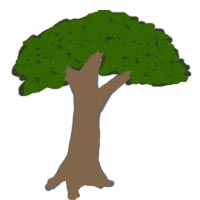
|
The god of armies and warriors, Urdak (urh-DAK) is all about
military might. He usually appears on the field of battle as a
hobgoblin in plate armor riding a dark brown charger. On his
shield is a depiction of the iron oak tree that is his symbol.
Usually he is accompanied by his own army of dedicated
petitioners.
Dogma
Through the order and training of an army, its strength is
improved, and Urdak is the god of strength.
Clergy and Temples
Recognized by their god, the Ascendant Soldiers are potentially
the most powerful crusaders alive.
Time Of Change
The Ascendant Soldiers were in battle when Urdak went away. This
was their doom, as they suddenly lost their divine assistance.
Some superstitious still say prayers to Urdak before battles, but
most put more faith in their weapons.
VICTOTHUS
Goddess of Righteousness
|
Intermediate Deity
Symbol: Gray silhouette of a battleaxe on a field of
brown split diagonally by red
Colors: Brown and red
Alignment: Chaotic Good
Portfolio: Honor, Retribution, Zeal
Worshipers: Barbarians, Fighters, Warrior-Clerics,
Centaurs
Cleric Alignments: CG, CN, NG
Domains: Good, Mysticism, Retribution, Wrath
Favored Weapon: Battleaxe
|
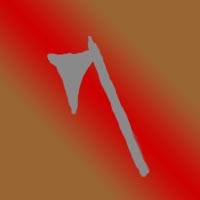
|
As the god of zealotry, Victothus (vick-TOE-this) is somewhat of
a mercenary that fights for any good cause if given enough of a
reason. It is important to her that she can fight passionately,
whatever the cause. Victothus appears as a Centaur with red and
brown leather armor wielding two battleaxes.
Clergy and Temples
Chief among her followers are the Crusader Zealots (see
Sanctified One of Kord, CC 99).
Time Of Change
The battle clerics and Crusader Zealots of Victothus have had a
hard time adapting to the loss of their god. Many have lost their
way and have fallen to thievery or alcoholism. The same spirit
that made them righteous warriors is eating them up inside with
feelings of failure and helplessness.
VORMALIS
God of the Hunt
|
Lesser Deity
Symbol: Black wolf track on a forest green field
Colors: Black and forest green
Alignment: Neutral
Portfolio: Hunting, Watchfulness
Worshipers: Hunters, Scouts, Rangers, Firbolgs,
Forest Giants, Lupins
Cleric Alignments: CN, LN, N, NE, NG
Domains: Animal, Celerity, Fate, Knowledge
Favored Weapon: Longbow
|
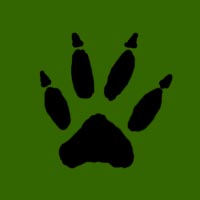
|
The god of the watch and the hunt, Vormalis (vohr-MAL-iss) holds
tracking and scouting in high esteem. To him, it isn't the kill
that matters, it is the patience and stalking, closing in and
striking when the time is right. Vormalis normally appears as a
Forest Giant with green and black leathers using arrows with
green and black fletchings that are razor sharp.
Clergy and Temples
In the high ranks of the church are the hunter assassins known as
the Black Hunters.
Time Of Change
The church of Vormalis has maintained its position within the
Lupin and Forest Giant societies. Even without the presence of
the god, it's teachings remain valid and its skill undiminished.
Though no longer a formal group, the Black Hunters are still well
respected.
WHENASTIL
God of Imprisonment
|
Intermediate Deity
Symbol: Gray ball and chain shackle on a white field
Colors: Gray and white
Alignment: Lawful Evil
Portfolio: Containment, Fate, Slavery
Worshipers: Jailers, Slavers, Illithids
Cleric Alignments: LE, LN, NE
Domains: Domination, Fate, Sloth, Summoner
Favored Weapon: Net
|
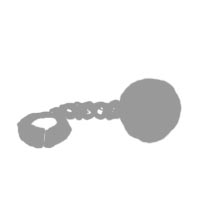
|
The creator of fate, Whenastil (wen-a-STILL) takes joy in
imprisonment and slavery. He usually appears as whatever race he
is appearing to, but always wears white robes with chains wrapped
around him.
Clergy and Temples
Feared most among the clergy are the order known as Soul Binders,
which take great delight in magical holds and bindings.
Time Of Change
The magical prisons of Whenastil failed when magic cut out, but
his clerics were able to contain the problem. When his clerics
also lost power, those that were to be held in were no longer
able to be controlled. Slave revolts and jail breaks happened
across the globe, resulting in the death of many of Whenastil's
clergy. Those that survived have learned to rely more on mundane
ways of keeping prisoners and slaves.
XILMOR
God of Bloodshed
|
Intermediate Deity
Symbol: A bloody hand clawing at a black field
Colors: Pale yellow and blood red
Alignment: Chaotic Evil
Portfolio: Killing, Murder, Slaughter
Worshipers: Barbarians, Mercenaries, Ettins,
Fomorian Giants, Gnolls, Orcs, Trolls
Cleric Alignments: CE, CN, NE
Domains: Destruction, Metal, Strength, Wrath
Favored Weapon: Greatsword
|
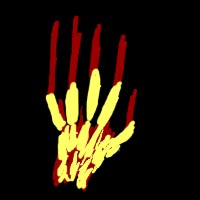
|
Xilmor (ZILL-more), god of slaughter, delights in killing and
bloodshed. Particularly, it seams, he enjoys the slaughter among
Elves, though this may be due to his Orc heritage. Xilmor always
appears as an Orc in bloody armor with numerous battle scars,
including a missing eye. Everywhere he stands or steps, he leaves
bloody boot prints.
Clergy and Temples
The most experienced crusaders of Xilmor are the Bloody Claws
(see Eye of Gruumsh, BW 31), a group of merciless battlers that
delight in the slaughter of elves in particular.
Time Of Change
The orcs became disheartened and then furious when their god
Xilmor left them. At first they took it out on the weaker clergy,
and then on their rulers. In the end, the orc kingdoms had
splintered into warring tribes. The Blood Claws lead the
strongest of the tribes.
XOLPHIRIS
God of Depths
|
Intermediate Deity
Symbol: A black spiral on a deep blue field
Colors: Deep blue, often with black
Alignment: Chaotic Evil
Portfolio: Cold, Deep Water, Whirlpools
Worshipers: Pirates, Aboleths
Cleric Alignments: CE, CN, NE
Domains: Chaos, Cold, Ocean, Water
Favored Weapon: Shortspear
|

|
The god of the cold, dark ocean depths, Xolphiris (zohl-FEER-iss)
is malicious and moody. He usually appears as an aboleth with
extra long tentacles and patches of dark blue scales. On land he
is forced to instead take on the appearance of a sea kin with
dark blue hide and eyes as deep as the sea.
Clergy and Temples
A few followers take on aspects of their deity and join the order
of Deep Guards.
Time Of Change
Most of the Deep Guard drowned when their god went away. Without
Xolphiris to support them, her clergy was quickly made
unimportant among the seafaring folk.
YILLIK
God of Perversion
|
Lesser Deity
Symbol: Bloody scalpel between a pair of dissected
eyes, intentionally phallic in nature
Colors: Green, silver, and blood red
Alignment: Neutral Evil
Portfolio: Abuse, Torture
Worshipers: Bards, Mad Scientists, Zerns
Cleric Alignments: CE, LE, NE, N
Domains: Domination, Evil, Madness, Suffering
Favored Weapon: Dagger
|
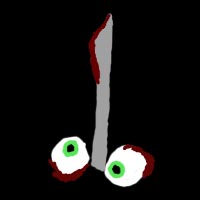
|
The God of Perversion, Yillik (YIHL-ik) is demented and sadistic,
gaining pleasure from the torturing of others and the slow
cutting of the flesh. He appears as a warped Zern wearing a
bloody apron and gloves.
Clergy and Temples
As torture specialists and adepts of transmutation magic, the
Transterrogators are looked upon with awe by other followers of
Yillik.
Time Of Change
The followers of Yillik didn't need him to pursue their twisted
agendas. The Transterrogators and his other clerics did, however.
The immortal Riz came to them and recruited them to his way, and
they followed easily with the promise of a twisted future.
YIXIMA
Goddess of Knowledge, The Lore Incarnate
|
Intermediate Deity
Symbol: Nondescript book with white pages on a
parchment yellow background
Colors: White and parchment yellow
Alignment: Lawful Neutral
Portfolio: Books, Knowledge, Teaching
Worshipers: Librarians, Wizards, Writers, Illumians
Cleric Alignments: LE, LG, LN, N
Domains: Knowledge, Mentalism, Oracle, Rune
Favored Weapon: Dagger
|
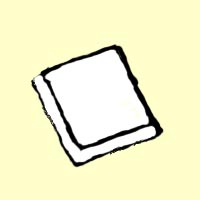
|
The Lore Incarnate, Yixima (YIKS-ih-mah), is a patient and
professor-like goddess. She appears as an illumian woman of small
stature, wearing white robes and glasses, and carrying a satchel
filled with books. Around her head are the power sigils "Uur"
(grace) and "Naen" (mind).
Clergy and Temples
Although rarely part of the clergy, the Paragnostic Apostles (see
Paragnostic Apostle, CC 94) are the preeminent scholars among the
church.
Time Of Change
While most of the gods just vanished, their power with them, the
clerics of Yixima felt a backlash when their goddess went away.
Struck blind, the clerics have been outcast and impoverished.
Many have committed suicide or died through other means. Out of
duty, the Paragnostic Apostles that were wizards rather than
clerics have taken up maintenance of the libraries.
ZIRDANAT
God of the Moon, The Night Watchman
|
Lesser Deity
Symbol: A three-quarters moon
Colors: Pale yellow and grey
Alignment: Neutral Evil
Portfolio: Moon, Night
Worshipers: Lycanthropes, Nocturnal Creatures,
Rangers, Rogues
Cleric Alignments: LE, N, NE, CE
Domains: Darkness, Evil, Moon, Trickery
Favored Weapon: Shortbow
|

|
The Night Watchman, Zirdanat (ZEER-din-at) is rumored to be the
son of Pheron and Malgondis. He is a shrewd and vigilant god
known to stir passions among those who worship or see him. When
he appears, he is a lupin with flaxen fur and pale green eyes
dressed in black leathers.
Clergy and Temples
During the day, the Howling Knights are capable warriors, but
when the moon is out their divine rage is terrifying to behold.
Time Of Change
The first night after the fall of the gods, the moon didn't rise.
Most passed this off as new moon, but many were more aware and
new it to be unnatural. That night, a frenzy tore through
lycanthropes, including lupins and the Howling Knights. When the
blood settled and morning arrived, their numbers had been greatly
reduced and they found themselves hunted across the countryside.
ZOLFRIN
Goddess of Trickery
|
Lesser Deity
Symbol: A white arrow head on a light blue field
Colors: Light blue and white
Alignment: Neutral Good
Portfolio: Humor, Tricks
Worshipers: Bards, Pranksters, Rogues
Cleric Alignments: CG, LG, NG, N
Domains: Illusion, Liberation, Luck, Trickery
Favored Weapon: Dart
|

|
Zolfrin (ZOHL-frin) is a friendly, though sometimes irritating,
goddess that loves to pull pranks. When she appears, she is a
halfling wearing light blue wrappings carrying a wand with an
arrow head on the tip.
Dogma
Humor is important in life. You must be able to laugh not only at
others, but at yourself as well. Pranks and jests can be a good
thing, though be careful not to be mean. Proper tricks can
actually improve trust between people and help form a closer
relationship. It's good to help others to understand these
things.
Clergy and Temples
The church of Zolfrin doesn't maintain any temples as most of its
members don't have the attention span or capacity for paperwork
required to run a building. Instead, individuals or communities
may host shines to the goddess. Though the religion doesn't have
temples, it does have structure, and the head of the church is
the Supreme Enlightener. A month into the planting season, it is
very common for communities to celebrate a holy day to Zolfrin
where pranksters run amuck. It helps remind people to lighten up
once in a while and is a excellent recruiting event for the
church. Priests of Zolfrin tend to be clever and personable,
often dedicating some of their studies to illusions. Chief among
the goddess' followers are the Favored Shades (see Sanctified One
of Olidammara, CC 99), an order of stealthy and lucky champions.
Clerics of Zolfrin pray for their spells just before evening, as
that is usually the beginning of time dedicated to merriment.
Time Of Change
The loss of Zolfrin destroyed the loose structure that was her
church. Her teachings have continued, and the Spring Fools Day
still is celebrated commonly.
REMAINING DEITIES
Not caring much for civilization, Balm didn't go out of his way to get new followers. Still, he
accepted any from Exolindius, Heimeus, Inunallah, Kupria,
Kolinbar, Omethis, Opherus, or Xolphiris that asked for his
aid.
Dirj is a caring god and actively had his
followers offer aid to any elf in need, or any follower of
Faiisbar, Haijisa, Pheron, Redomel, Talwerian, or Tolondar.
Through this, many common-folk have converted to workshiping
Dirj.
The Brothers and Sisters of Freedom were
dispatched by Jahnian the first
moment possible after the loss of the other gods. His followers
helped to protect any church that need it, with particular
interest in the followers of Demos, Holontier, Norral, and
Pariontor.
Jilis found herself preoccupied by the
new gods and was taken aback by the intensity of the backlash
against the clerics of the former gods of good. Her help was too
slow for the clergy of Femola and Cilinda, and those of Ruminis
were too stubborn and ready to sacrifice their lives. The
churches of Sangiban and Victothus were too absorbed in self-pity
to accept aid, but the paladins of Stalnor gladly took her
help.
With magic already in chaos, and Yixima having
been destroyed, Morn found herself
hesitant to get involved in the mortal upheavals with her already
small group of followers. She worked silently through dreams and
pulled the remaining followers of Chihare, Ledorian, Yixima, and
Zolfrin to her.
The church of Nar-Ikvar
has always been powerful and busy. While he
didn't try to aid the churches of Anadil, Avalon, or Gil,
Nar-Ikvar worked to fill the gap left by their collapses. With
the undead plague, his followers took clear leadership in the
fight against the menace.
The followers of Merran, Egrolius, and Iomilia
got immediate and unexpected support from the church of
Nurbias. Most of the time the fact that
the support came from Nurbias was hidden and it took a long time
for many of those followers to actually convert.
With the upheaval, Sazia
made out well. Followers from Benesius, Canluth,
Desela, Dahjihai, Erimeth, Gorhal, Malgondis, Qolgorital,
Whenastil, Xilmor, and Zirdanat all proved easy converts. She
even sent out demons and devils to establish pacts with the
followers of the good gods that had lost their way.
Not interested in the politics, but disturbed by
the poorly orchestrated warring, Wick started to get directly involved. He not only sent his
church to aid and recruit from the followers of Dizga, Kazt,
Lamtorak, Vormalis, and Urdak, but he spent a great deal of time
marching in the world himself.
It was during the celebration for the rise of a
new honorable king in a small northern kingdom that the first
followers of Ahma-Buddha came to
be. The champions of Iomillia and Demos were the most powerful of
the early converts. As wars continued and parties took place
before and after the fights, the new god found ample opportunity
to spread the word and to offer people the chance to win his
favor.
Yatta yatta yatta... Borlandir
...something something someting.
Worship of Illaron was slow to take hold. During times of great strife the
populous has more wories than personal expression. However, his
teachings took hold among the young, and as generations grew up
and bore more young, his influence spread. After decades, his
church had a strong foothold, particularly in dense population
areas.
During a great battle the flying ship that is
central to Jak's church was seen
for the first time, floating over head. The armies stopped and
stared, as a single gold coin fell from the sky. A soldier from
one side picked it up and the army from the other side suddenly
turned into rabbits and hens. It was from that winning army that
Jak's first followers came. As the story spread, so did his
influence. Combined with a ready supply of gamblers, the church
grew and prospered.
Jaringan replaced Haijisa as the god of
the sun, and did so with great furvor and more power. The delay
between his rise and her fall, however, was long enough for great
distruction to take place and a horde of undead to amass. Such
was the conditions, that the peoples' acceptance of his glory was
swift and his church rose to power quickly.
|


















































